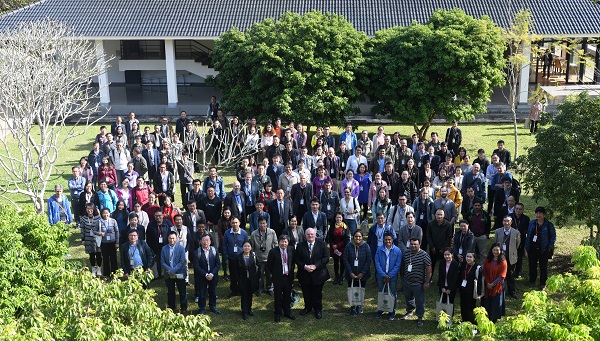| About Us |
| News |
| Announcement |
| Research |
| Conservation & Horticulture |
| Public Education |
| Graduate Study |
| Scientist |
| International Cooperation |
| Resources |
| Annual Reports |
| Publications & Papers |
| Visit XTBG |
| Societies |
| XTBG Seminar |
| Open Positions |
| CAS-SEABRI |
| PFS-Tropical Asia |
| Links |
| Location:Home > International Cooperation > Int’l Cooperation News |
| Fourth Xishuangbanna International Symposium held to mark 60th anniversary of XTBG |
|
The 4th Xishuangbanna International Symposium was held from January 3-5 to mark the 60th anniversary of Xishuangbanna Tropical Botanical Garden (XTBG). With the general theme of “Saving all the plants in a changing world”, the symposium brought together more than 200 scholars from 15 countries and regions. There were 12 keynote speeches and 74 posters concerning frontiers of conservation science, the development of institutional policy, the educational role of botanical gardens, and current progress in plant conservation. The symposium covered six major sessions, namely Frontiers in conservation science, Post-2020 Global Strategy for Plant Conservation (GSPC): national and regional partnerships, China’s Belt & Road Initiative: opportunities for botanical garden partnerships, Conservation and climate change, Education for plant conservation, Plant evolution and conservation: insights from genomics. The keynote speakers included Prof. Peter Wyse Jackson of Missouri Botanical Garden, Prof. Paul Smith of Botanic Gardens Conservation International (BGCI), Prof. Pete Hollingsworth of Royal Botanic Garden Edinburgh, Dr. Valerie Pence of Cincinnati Zoo & Botanical Garden, Dr. Samuel Brockington from University of Cambridge, and Prof. Chuck Cannon of The Morton Arboretum, and others. The sessions offered some potential solutions to the challenges of saving all of plant diversity and show how botanical gardens can play a key role. After full discussion, the participants at the symposium released The Xishuangbanna Declaration on Plant Conservation. The participants call for all botanical gardens to place plant conservation as top priority in their missions, and to engage with their management authorities, funding agencies, sponsors, visitors, local communities, and other stakeholders to increase the scale and effectiveness of plant conservation actions to ensure that no plant species goes extinct. The Xishuangbanna International Symposium, held every five years, aims to bring together leading scientists to present cutting-edge research, address current debates, and assess future directions for research and action on biodiversity conservation and botanical gardens.   12 keynote speakers at the symposium  Discussion and communication at the symposium  Participants pose a photo. Full Text of declaration: The Xishuangbanna Declaration on Plant Conservation The participants in the Fourth Xishuangbanna International Symposium, Saving all the Plants in a Changing World, held at the Xishuangbanna Tropical Botanical Garden, Chinese Academy of Sciences, Yunnan, China, on January 3-5th, 2019 1. Recognizing that plant diversity forms the essential basis for natural ecosystems and human well-being. 2. Recognizing that the maintenance of plant diversity is essential for the achievement of important international objectives, including the Sustainable Development Goals (SDGs), the Strategic Plan for Biodiversity, and the objectives of the U.N. Convention on Biological Diversity (CBD), as well as National Biodiversity Strategies and Action Plans (NBSAPs). 3. Noting in particular the contributions of plant diversity to the achievement of the following SDGs: eradicating poverty (SDG 1); preventing hunger (SDG 2); human health (SDG 3); clean water (SDG 6); affordable, clean energy (SDG 7); sustainable cities and communities (SDG 11); climate action (SDG 13); and life on land (SDG 15). 4. Acknowledging that there are continued and growing threats to plant diversity worldwide from many factors including habitat loss and degradation, unsustainable exploitation, pollution, invasive species, and climate change. 5. Noting that there are no technical reasons why any plant species should go extinct, since in situ conservation in protected areas and other sustainably managed habitats, complemented by ex situ conservation in seed banks, cryostorage, and living collections, is sufficient to conserve every known rare and threatened species. 6. Consider, therefore, that the extinction of any known plant species is inexcusable. 7. Recognizing also that the unique combination of expertise, experience, skills, and resources of the world’s botanical gardens are available to undertake effective plant conservation, and represent the interface between scientific research, horticulture, conservation and public education. 8. Acknowledge that many botanical gardens are already making significant contributions to plant conservation, but accept that there is an urgent need to scale up existing activities both individually and through joint actions with partner networks, agencies, and other organisations. 9. Pointing out that the Global Strategy for Plant Conservation, adopted by the CBD in 2002 and updated in 2011, has provided an essential framework for plant conservation worldwide and achieved considerable progress towards the achievement of its objectives.
Therefore, the participants of the Xishuangbanna International Symposium 2019:
10. Urge botanical gardens and all other institutions involved in botanical research and plant conservation to use their individual and collective capabilities and resources to: a. accelerate completion of the global plant species inventory, since it is not possible to target conservation of unknown or undescribed species; b. support development of effective species identification tools to improve the protection of species threatened by illegal or unregulated trade; c. complete assessments of the risk of extinction for all known plant species, so that conservation efforts can be efficiently targeted towards those that are most in need of conservation action; d. design, designate, protect, and manage more protected areas and other sustainably managed habitats, especially those that represent important areas for plant diversity, in order to conserve threatened plant species in nature, in situ, where they can continue to evolve as resilient populations and continue to support associated species; e. research and monitor wild populations of rare, threatened, and declining species and ensure that they are subject to active conservation programmes aimed at achieving self-sustaining and viable populations in the wild; f. continue to develop complementary measures to support the safeguarding and recovery of rare and threatened plant species, including ex situ measures such as genetically-diverse and complementary collections held in seed banks, cryobanks, and living collections; g. determine seed storage capabilities and propagation methods for all known rare and threatened species in order to provide the most effective and efficient methods of ex situ conservation; h. undertake new initiatives in conservation translocations and expand the scale of ecological restoration to support the recovery of threatened plants and their habitats; i. educate the general public, decision-makers, and students of all ages about the importance of plants and their essential value for human wellbeing, as well as the need for plant conservation and the means by which this can be achieved; j. engage local, regional, and global leaders in the development of policies and practices that secure the continued survival of all plant species; k. participate in the development of active and collaborative plant conservation networks aimed at ensuring that gaps are filled in plant conservation and in the supporting research knowledge needed;
11. Call for all botanical gardens to place plant conservation as a top priority in their missions, and to engage with their management authorities, funding agencies, sponsors, visitors, local communities, and other stakeholders to increase the scale and effectiveness of plant conservation actions to ensure that no plant species goes extinct. 12. Further call for the establishment of new botanical gardens and greater support for existing botanical gardens in areas of high plant diversity and with climatic and biogeographical characteristics that are under-represented in the existing network as safehouses for plant biodiversity. 13. Finally, the participants urge the Parties to the CBD to give urgent attention to the development of an updated Global Strategy for Plant Conservation for the post-2020 period, containing agreed measurable outcome targets that contribute towards the proposed post-2020 Global Biodiversity Framework and the achievement of the Sustainable Development Goals. |
| Appendix Download |
|
|
